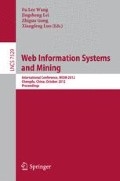Abstract
The basic idea of identifying the motion blurred direction using the directional derivative is that the original image be an isotropic first-order Markov random process. However, the real effect of this method is not always good. There are many reasons, of which the main is that a lot of pictures do not meet the physical premises. The shapes of objects and texture of pictures would be vulnerably influenced for identifying. In this paper, according to the image characteristics of the local variance, we extract multiple blocks and identify the motion directions of the blocks to identify the motion blurred direction. Experimental results show that our method not only improve the identification accuracy, but also reduce the amount of computation.
Access this chapter
Tax calculation will be finalised at checkout
Purchases are for personal use only
Preview
Unable to display preview. Download preview PDF.
References
Cannon, M.: Blind deconvolution of spatially invariant image blurs with phase. IEEE Transactions on Acoustics, Speech and Signal Processing 24(1), 58–63 (1976)
Fabian, R., Malah, D.: Robust identification of motion and out-of-focus blur parameters form blurred and noisy image. CVGIP: Graphical, Models and Image Processing (53), 403–412 (1991)
Ji, H., Liu, C.: Motion blur identification from image gradients. In: IEEE Conference on CVPR, pp. 1–8 (2008)
Krahmer, F., Lin, Y., McAdoo, B., Ott, K., Wang, J., Widemannk, D., Wohlberg, B.: Blind image deconvolution: motion blur estimation. Tech. Rep., University of Minnesota (2006)
Zou, M.-Y.: Deconvolution and Signal Recovery. National Defence Industry Press, Beijing (2001)
Yitzhaky, Y., Mor, I., Lantzman, A., et al.: Direct method for restoration of motion-blurred images. Journal of Optical Society of American 15(6), 1512–1519 (1998)
Yitzhaky, Y., Kopeika, N.S.: Vibrated image restoration from a single frame. In: The International Society for Optical Engineering, SPIE, vol. 3808, pp. 603–613 (1999)
Yitzhaky, Y., Milberg, R., Yohaev, S., et al.: Comparison of direct blind deconvolution methods for motion-blurred images. Applied Optics 38(20), 4325–4332 (1999)
Chen, Q., Lu, Q., Chen, L.: Identification of the motion blurred direction based on the direction of differential. Chinese Journal of Graphics 10(5), 590–595 (2005)
Yan, X., Liu, H., Liu, B.: Motion blur airspace estimation method based on the rotation difference operator. In: 15th National Image and Graphic Conference, pp. 18–23 (2011)
Lokhande, R., Arya, K.V., Gupta, P.: Identification of parameters and restoration of motion blurred images. Chinese Journal of Computers 30(4), 686–692 (2007)
Yitzhaky, Y., Kopeika, N.S.: Identification of blur parameters from motion blurred images. Graphical Models and Image Processing 59(5), 310–320 (1997)
Chen, Y.S., Choa, I.S.: An approach to eastimating the motion parameters for a linear motion blurred image. IEICE Transactions on Information System E83-D(7), 1601–1603 (2000)
Author information
Authors and Affiliations
Editor information
Editors and Affiliations
Rights and permissions
Copyright information
© 2012 Springer-Verlag Berlin Heidelberg
About this paper
Cite this paper
Li, J., Chu, C., Li, G., Lou, Y. (2012). A Blocked Statistics Method Based on Directional Derivative. In: Wang, F.L., Lei, J., Gong, Z., Luo, X. (eds) Web Information Systems and Mining. WISM 2012. Lecture Notes in Computer Science, vol 7529. Springer, Berlin, Heidelberg. https://doi.org/10.1007/978-3-642-33469-6_13
Download citation
DOI: https://doi.org/10.1007/978-3-642-33469-6_13
Publisher Name: Springer, Berlin, Heidelberg
Print ISBN: 978-3-642-33468-9
Online ISBN: 978-3-642-33469-6
eBook Packages: Computer ScienceComputer Science (R0)

